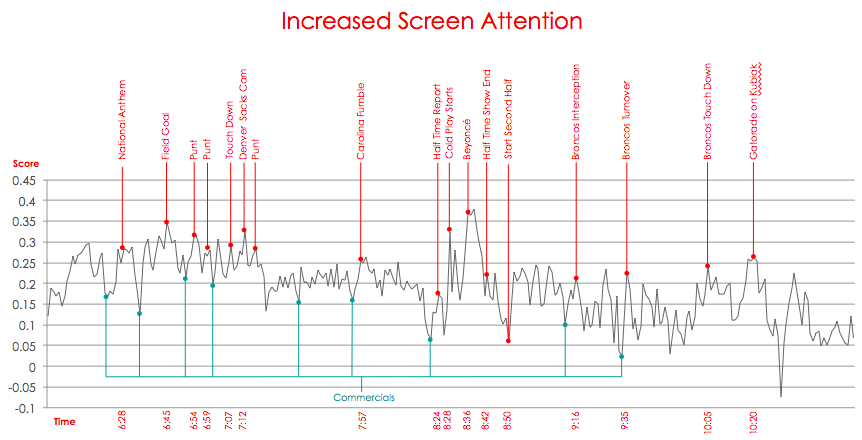The Super Bowl Ads and Moments That Best Caught – and Kept – Viewers’ Attention
We’ve seen reams of critical analysis of the Super Bowl ads, creative reviews, rankings based on consumer preferences, even an evaluation of spots with the potential to drive business. But which ads did viewers actually pay attention to during the broadcast?
Fresh from our data-analytics work analyzing the core constituencies of the winning candidates at the Iowa caucuses, we sought to answer that question by measuring when viewers were using their mobile devices — an indication of when they were not looking at the TV.
We compared overall U.S. mobile device activity during the five hours of the Super Bowl broadcast (from 6 p.m. to 11 p.m. ET on February 7th) to the corresponding period from the prior week, tracking that activity in 10-second intervals. We postulated that any drop in mobile activity would indicate increased TV screen attention, and correspond with major events during the game. We established a framework that scored viewer engagement for each interval as the percentage decrease in mobile bid requests between January 31st and February 7th. Those decreases ranged between 5% and 40%, as shown below:
The results were stunning. We found that every spike in viewer engagement (relative drop in mobile usage) corresponded with a major event during the game. And every low point in viewer engagement corresponded with a break in the game.
So how did we monitor mobile devices? For most ads seen on web browsers and mobile devices, there is an auction among programmatic advertising firms for the chance to show consumers an ad. We are one of the buyers in these auctions, and we receive a variety of anonymous data, including type of phone, app used, browser URL visited, and operating system. We observe tens of billions of these events a day.
When people are paying attention to the TV screen, they are using their phones less. During major game events, people paid less attention to their mobile devices, just as you’d expect. We saw large decreases in mobile engagement during important points in the game, including scoring plays, turnovers and controversial calls (and, as it turned out, during Beyonce’s arrival on stage). Low user engagement with phones appears to be highly correlated with high user engagement with the television. Once we established this correlation, we used our mobile usage index to evaluate attention paid to each of the 82 Super Bowl ads (excluding network and NFL promotions).
Here are some of our findings:
– Half of the top 10 moments for commanding viewer attention during the broadcast were non-football events, led by Beyonce’s halftime performance, the Armed Forces rendition of “America the Beautiful,” and the players’ dumping Gatorade on victorious Coach Kubiak.
– Viewers engaged with ads early and lost interest as the game went on. Eighteen of the top 20 most-viewed ads were aired during the 1st quarter. Adweek’s top five included three — Jeep “Portraits,” T-Mobile “Bling” and Heinz “Weiner Parade” — that drew relatively low viewership as they were aired during the late 3rd and 4th quarters.
– The most viewed ads ran in blocks. Among them: Michelob Ultra (#6), Snickers (#5), SoFi.com (#1), Avocados from Mexico (#14) after the first Broncos field goal; Mobile Strike (#7), Doritos (#9), PayPal (#2) after the first Panthers drive; Mountain Dew Kickstart (#8), Taco Bell (#4), Marmot (#15) during the review of the disputed 1st quarter Panthers catch; Shock Top Beer (#10), Buick (#3), Advil (#13) after the controversial taunting penalty on Aqib Talib.
– Stars helped marketers garner more attention. Perhaps not all stars, but these three:
– Hyundai Genesis (#12), starring Kevin Hart, ran alone after the coin toss and claimed significantly more viewership than the critically acclaimed (by both Advertising Age and Adweek) Hyundai Ryanville.
– TurboTax (#16), starring Anthony Hopkins, was the only second half ad in our top 20.
– Horror film 10 Cloverfield Lane (#18), starring John Goodman, got attention after Lady Gaga’s winning performance of the national anthem, but viewers retreated to their small screens before Intel and Esurance could pitch.
The top 20 most-viewed commercials, scored and timestamped:
| Score | Advertiser | Time |
| 0.408 | Sofi.com | 18:47:01 |
| 0.373 | PayPal | 18:55:05 |
| 0.369 | Buick | 19:17:00 |
| 0.359 | Taco Bell | 19:03:04 |
| 0.356 | Snickers | 18:46:04 |
| 0.354 | Michelob Ultra | 18:46:02 |
| 0.344 | Mobile Strike | 18:54:05 |
| 0.344 | Mountain Dew Kickstart | 19:03:01 |
| 0.342 | Doritos | 18:55:02 |
| 0.327 | Shock Top Beer | 19:16:03 |
| 0.322 | Jungle Book | 18:59:02 |
| 0.314 | Hyundai Genesis | 18:36:04 |
| 0.312 | Advil | 19:17:03 |
| 0.309 | Avocados from Mexico | 18:47:04 |
| 0.303 | Marmot | 19:04:01 |
| 0.3 | Turbotax | 21:01:03 |
| 0.297 | Audi | 18:59:05 |
| 0.291 | 10 Cloverfield Lane | 18:32:00 |
| 0.288 | Coca-Cola | 19:57:04 |
| 0.287 | Squarespace | 19:08:04 |
Read the full article on Forbes



